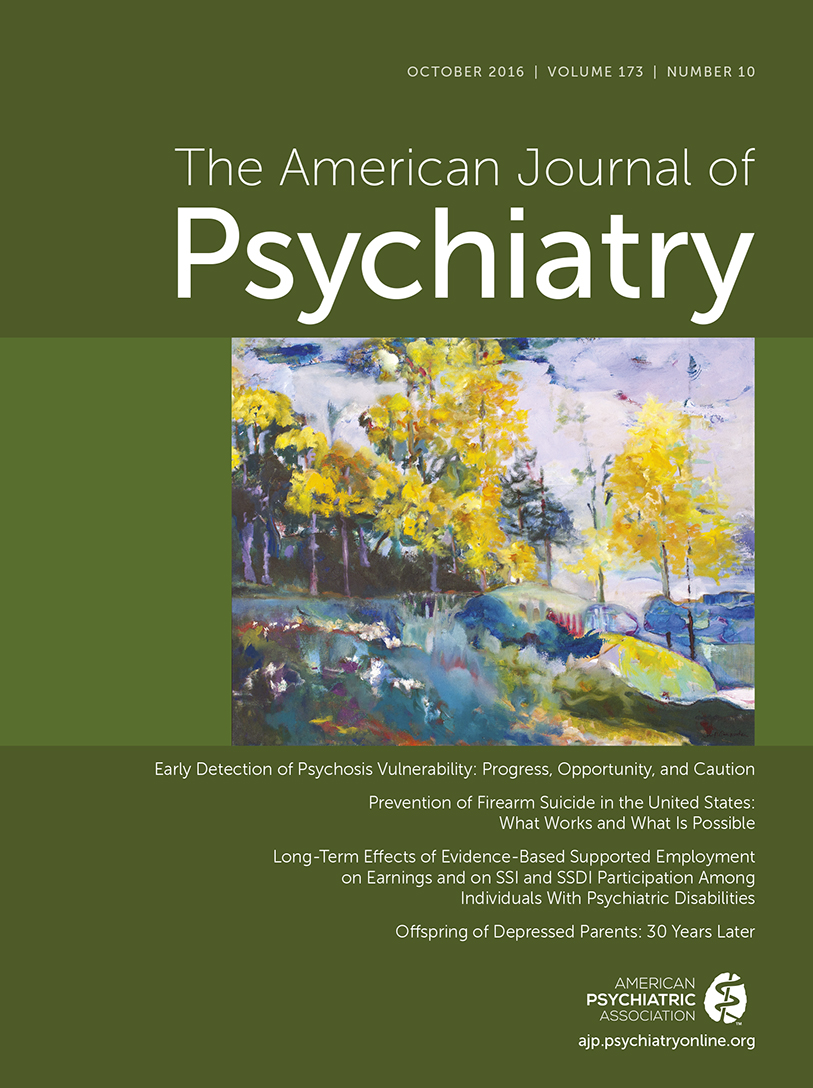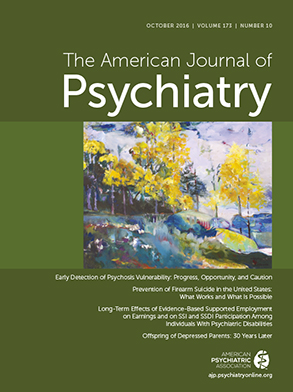In this issue of the
Journal, Weissman and colleagues (
1) report on the 30-year outcomes of 147 offspring of depressed and nondepressed parents. Long interested in depression among women and its effects on functioning in social roles, since the early 1970s, Myrna Weissman was one of the very first to systematically evaluate the effects of parental depression on children’s mental health. Her research on offspring led efforts to refine parental disorder by modern DSM criteria to distinguish unipolar from bipolar conditions and to include direct diagnostic interviews. Because depression is a fairly common but exceedingly debilitating condition, and critically because it most frequently affects women in their child-bearing years, the impact of maternal depression is an enormous public health concern that has attracted considerable attention over the years. Weissman’s pioneering project played an enormous role in stimulating such research efforts.
The original offspring sample 30 years ago (ages 6–23; mean age: approximately 17 years old) was comprised of 125 offspring of depressed probands and 95 children of 35 control subjects. The depressed parents, mostly mothers, were mainly drawn from the Yale University Depression Research Unit, and the well parents were recruited from the community. The initial results were published in the late 1980s, with a 10-year follow-up of the offspring reported in 1997 and a 20-year follow-up reported in 2006. The present study is a 30-year follow-up of 103 available individuals from the depressed parent sample and 44 from the control sample (mean age: approximately 48 years). Similar assessment procedures were maintained across all waves of the study for comparability, and those who were retained essentially did not differ from those who were lost to follow-up or who declined to participate. The findings show approximately three times the rate for major depression in the high-risk group compared with the control group, and offspring at risk also had significantly higher rates of phobia, as well as elevated rates of substance use disorders that nearly reached statistical significance. Results indicate that the period of greatest risk for offspring of depressed parents is ages 15–25 (with a low but comparatively higher rate of prepubertal onset). Early-onset (<20 years old) strongly predicted recurrence of major depression. Extending the period of follow-up to 30 years indicates that first onsets at later ages were generally less common for offspring of either parental group. Importantly, the offspring of depressed parents also were at continuing high risk for poor functional outcomes (Global Assessment Scale scores), less likely to be currently married, and have fewer children. They had higher rates of and longer treatment for emotional disorders. Frequency of medical conditions did not differ in the two offspring groups, but all of the deaths due to “unnatural causes,” such as overdose or suicide (N=5), were in the high-risk group.
A large volume of research by many investigators has now confirmed that children of depressed parents experience elevated rates of depression and anxiety and higher levels of externalizing disorders—and generally display a variety of cognitive and social impairments that are relatively enduring (
2,
3). However, the long follow-up period reported by Weissman and colleagues is mostly unparalleled. It brings into focus that the impact largely begins within the first two decades of life and lasts a lifetime, implying the need for early intervention. Studying participants who are now in early middle-age also hints of increased mortality among depressed offspring of depressed parents and likely portends greater morbidity associated with depression.
The implications of the long-term findings obviously support the necessity for attention to the mental health needs of the entire family when parental depression occurs. In addition to early-onset and recurrent depression and functional impairment, the pattern also implies continuing intergenerational transmission of depression, which is reported elsewhere (
4). Weissman and colleagues, as well as many other investigators, have promoted interventions including a range of efforts beyond individual treatment, such as maternal depression screening during the peripartum period, enhanced parental support to depressed mothers, early intervention for depressed adolescent offspring, and family depression prevention strategies for depressed adults. Such interventions are promising, but there are many obstacles and complexities, including those at the levels of policy, resources and dissemination, and funding (
5). The sheer magnitude of the problem owing to high rates of depression in women, at the very minimum, requires training in awareness among health service providers that depression is far more than an impairing disorder experienced solely by an individual. The study encourages robust interventions both for parents and their children in order to disrupt clinical and functional processes that are otherwise pervasive and likely progressive in their negative consequences.
The study by Weissman and colleagues includes a fairly small clinical sample and limited geographic and ethnic diversity, although the basic fact that children of depressed parents are at risk has been replicated in community studies widely varying in demographic composition, including children across age ranges. However, many questions remain. There has been considerable research in the past couple of decades continuing on the mechanisms of depression, implicating genetic, biological, and psychosocial factors interacting in complex and dynamic ways. While depression is known to be moderately heritable, maternal depression typically occurs in the context of challenging environmental conditions, including marital relationship instability, stressful life circumstances, and parenting difficulties. Considerable contemporary research continues to refine and focus understanding of the contributing factors that predict and explain risk to children. Further research also addresses the question of which children may be at greatest risk and attempts to frame the resilience and protective factors that can be marshalled to help depressed parents and their children.
Myrna Weissman and her colleagues are to be commended for their remarkable persistence and dedication to the 30-year project. It has produced numerous additional findings on depression well beyond those reported here—and hopefully continues.

